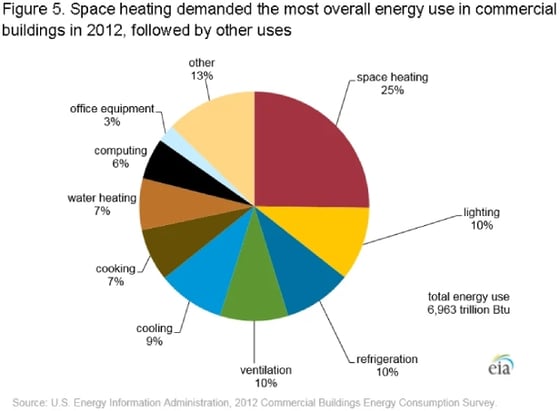Energy consumption in commercial buildings is crucial to the management and sustainability of commercial properties. Based on a 2016 EIA (Energy information Administration) energy report, commercial and residential buildings accounted for as much as 40% of the total US energy consumption. This invariably puts energy consumption among the top expenses in the financial statements of commercial buildings.
There are several factors affecting energy efficiency in commercial buildings. Broadly, these factors can be split into internal and external factors, representing controllable and non-controllable factors respectively. Some of the internal factors include building occupants, purpose of the commercial building, location of the building, types of equipment used in the building (for example, the heating ventilating and air conditioning (HVAC) unit). With respect to external factors, weather is the predominant non-controllable factor affecting energy consumption in commercial structures.
NASA defines weather as the condition of the atmosphere over a short period of time, as opposed to climate, which is the behavior of the atmosphere over a long period of time (usually a couple of years).
This article will be particularly focused on the effects and importance of measuring and correlating short-term atmospheric conditions on energy efficiency in commercial buildings. The short term atmospheric conditions being considered will include temperature, humidity, wind movement, etc.
Weather has always been a challenge for almost all building owners and facility managers. Extreme weather conditions as well as occurrences such as hurricanes and blizzards cause power outages, power supply shortages and brings down facilities. They create a huge increase in insurance costs, operating costs and productivity losses. A study led by National Center for Atmospheric Research (NCAR), states that routine weather events such as rain and cooler-than-average days can add up to an annual economic impact of as much as $485 billion in the United States and the impact of routine weather variations on the economy is as much as 3.4 percent of U.S. GDP (gross domestic product).
According to the US Energy Information Administration, HVAC systems accounted for the highest consumption of energy in commercial buildings. Therefore implying that the effect of weather conditions on energy efficiency in commercial buildings can be directly linked to its effect on the use of HVAC systems.

Installing energy efficient HVAC systems will without doubt cut down energy cost, thereby improving energy efficiency. However, the utilization of the energy efficient systems will be the same as with any other system, only at a lower cost.
The overall purpose is to find out how understanding the weather and its patterns could eventually lead to a reduction in the use of energy consuming equipments in commercial buildings.
Methods of Weather Data Collection by commercial Buildings:
One of the main hindrances commercial building managers face in collecting and correlating weather data, is the lack of equipment and devices with which to effectively collect and manage this data as well as establish a relationship between the collected data and their impact on their building’s energy consumption. Some managers may see this as a complete waste of time and resources. But weather conditions have been proven to have an impact on the energy consumption of buildings. A simple and most common scenario is the act of turning on an air conditioner or lowering its temperature further in extreme heat.
With the current advancement in commercial buildings, and with smart buildings set to be the future of commercial properties, the Internet of Things (IoT) is the best way through which commercial properties can collect, compile, interpret and draw meaningful information from weather data. Placing sensors in all the components of the building’s HVAC system and linking it to a Building Management System (BMS) or analytic software accomplish this. By further liaising the collected data with that from the local weather center, commercial buildings could have real time correlated data on the weather.
Below we take a look at the impact of implementing an IoT system that can incorporate weather data into the daily operations of your building.
Impact of weather data on energy efficiency in commercial buildings:
1.Better performance: The importance of weather forecast cannot be overstated in any commercial venture. Forecasting provides building managers with arguably the most valuable resource known to man – time. A commercial building, which collects and compiles data on the weather based on the location in which the building is situated can adequately predict when temperatures will be high or low in the near future. With this information, the management of the building can have ample time to make the necessary preparations to accommodate the building’s needs. This proactive move could entail redirecting energy from the heating system to the cooling system in warmer days and the reverse in colder days. Hence avoiding extra energy consumption from having both the cooling and heating systems running at full capacities (in anticipation of occupants needs), irrespective of the weather conditions.
Based on the accumulated weather condition for a given period of time, commercial buildings can predict with a certain degree of certainty as to how the following periods weather conditions and the impact it will have on the building’s energy consumption. This provides flexibility in planning and budgeting along tangible outcomes.
2. Optimized Responses: With the advent of IoT technology, commercial buildings have at least one form of smart device running within the property. It doesn’t matter if it is a smoke sensor in the kitchen or a motion sensor in the lobby cameras, most commercial buildings have some form of smart installation. By incorporating data from the weather, these sensors can be further programmed to relay automated energy-saving actions.
A commercial property using the Internet of things can program it’s heaters to automatically fluctuate temperatures with respect to the weather, while ensuring that the room or sector’s temperature stays at the same level as when the heater’s temperature was set.
For example, at a natural atmospheric temperature of 30oF, the temperature of the heater at the lobby can be set to 70oF.The sensors in the building could be programmed to not change the heater’s temperature with a proportionate change in the weather’s temperature, thereby keeping the lobby at a steady 70oF at all times. This goes a long way to enhance energy efficiency in commercial buildings as only the needed energy is being used at any point in time. The same can be done for every other energy-consuming device within the commercial building.
In addition, using the IoT sensors for weather related data could help with related events such as protection against flood damage. Most IoT sensors provide data such as temperature, wind speed, humidity and precipitation. When there is a forecast of heavy rain, the precipitation data can be particularly helpful in building defenses against flooding of your building. For facility managers, the complete set of data – IoT sensor data along with the weather forecast, supports faster decision-making.
3. Easy Maintenance: Maintenance is a constant with every commercial building. There is always the need to have components looked at or changed over time. A stormy day could make maintenance very hard or impossible to accomplish. Collecting and correlating data on the weather, allows for maintenance to be programmed on the best possible day when weather conditions will not stand in the way.
By incorporating the local weather data along with the equipment data like the HVAC, you can benefit by identifying the peak operating performance as well as when the equipment is not performing optimally.
This combination of data – from the IoT sensors and weather forecast, can also be viewed via reports, dashboards and graphics. These can reveal issues and opportunities for maintenance, which can be otherwise hard to detect.
You can also incorporate predictive modeling where a facility’s energy needs along with weather and utility rate can help you optimize energy consumption, demand response and optimal consumption of energy. The risk of failure can be predicted for critical equipment to enable proactive servicing or replacement to avoid expensive downtime and losses.
Conclusion:
In conclusion, weather remains one of the biggest challenges of facility management. But, with the advancement of technologies like IoT, buildings are increasingly using data from weather forecasts in conjunction with sensor data to increase the energy performance and optimize response time.
By combining this data along with advanced analytics, facility managers are also able to control their maintenance costs.
Though arguably difficult to control weather conditions, the data from weather forecasts can be collected and correlated to significantly cut down energy consumption in commercial buildings.
Learn more about our latest products and you will be on your way to transforming how your building performs.




